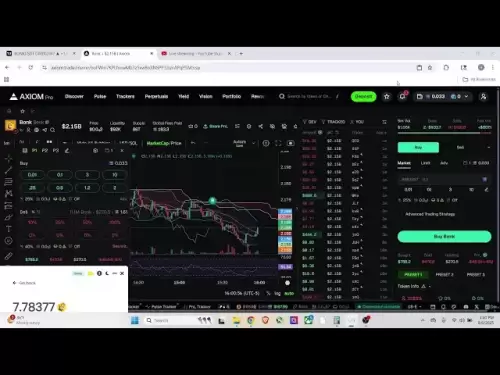-
 Bitcoin
Bitcoin $115100
1.27% -
 Ethereum
Ethereum $3675
2.71% -
 XRP
XRP $2.995
1.45% -
 Tether USDt
Tether USDt $1.000
0.02% -
 BNB
BNB $769.8
2.64% -
 Solana
Solana $168.0
3.25% -
 USDC
USDC $0.9999
-0.01% -
 TRON
TRON $0.3371
1.48% -
 Dogecoin
Dogecoin $0.2051
3.36% -
 Cardano
Cardano $0.7394
2.30% -
 Hyperliquid
Hyperliquid $38.15
0.42% -
 Stellar
Stellar $0.3966
-0.36% -
 Sui
Sui $3.486
2.93% -
 Chainlink
Chainlink $16.72
2.52% -
 Bitcoin Cash
Bitcoin Cash $568.0
4.36% -
 Hedera
Hedera $0.2440
2.59% -
 Ethena USDe
Ethena USDe $1.001
0.04% -
 Avalanche
Avalanche $22.16
2.06% -
 Litecoin
Litecoin $119.1
-0.73% -
 UNUS SED LEO
UNUS SED LEO $8.991
0.04% -
 Toncoin
Toncoin $3.232
-0.39% -
 Shiba Inu
Shiba Inu $0.00001233
2.82% -
 Uniswap
Uniswap $9.717
2.53% -
 Polkadot
Polkadot $3.664
1.85% -
 Dai
Dai $1.000
0.01% -
 Monero
Monero $281.2
-3.89% -
 Bitget Token
Bitget Token $4.350
1.55% -
 Cronos
Cronos $0.1428
5.07% -
 Pepe
Pepe $0.00001050
3.68% -
 Aave
Aave $262.3
3.54%
How to play Coinbase 5 times leverage
Coinbase's 5x leverage feature can amplify both profits and losses by a factor of five, emphasizing the need for a well-informed approach to leveraged trading.
Nov 11, 2024 at 05:00 am

A Comprehensive Guide to Utilizing Coinbase's 5 Times Leverage
Coinbase, renowned for its user-centric approach, has introduced a leveraged trading feature, enabling users to enhance their trading potential with 5 times (5x) leverage. This revolutionary tool offers traders the opportunity to magnify their returns, but it also requires a thorough understanding of its mechanics and potential risks. This extensive guide will provide a step-by-step explanation on how to utilize Coinbase's 5x leverage, helping you navigate the intricacies of leveraged trading with confidence.
Prerequisites for 5x Leverage Trading on Coinbase
Before delving into the practical application of Coinbase's 5x leverage, it is essential to fulfill the following prerequisites:
- Account Verification: Coinbase requires all users engaging in leveraged trading to complete the account verification process. This involves submitting personal information and undergoing identity authentication measures.
- Funding: To initiate leveraged trading, traders must ensure that their Coinbase account has sufficient funds. This can be achieved through fiat currency deposits, cryptocurrency transfers, or by linking a bank account.
- Margin Trading Eligibility: Not all Coinbase users are immediately eligible for marginalized trading. To qualify, individuals must complete a questionnaire that assesses their trading experience, knowledge, and financial situation.
Step 1: Activating Leverage on Coinbase
- Navigate to Leverage Trading: From the Coinbase dashboard, select the "Trade" option and switch to the "Advanced Trade" interface. In the top right corner, click on "Enable Leverage."
- Review and Acknowledge Risks: Before proceeding, carefully read and acknowledge the risks associated with leveraged trading. This includes the potential for significant losses exceeding the initial investment.
- Configure Leverage Setting: Coinbase offers adjustable leverage settings, including 2x, 3x, and 5x. For the purpose of this guide, select the "5x" option to initiate 5 times leverage trading.
- Confirm Activation: Once the leverage setting is selected, confirm the activation by clicking on the "Activate Leverage" button. This will grant immediate access to leveraged trading capabilities.
Step 2: Selecting a Trading Pair
- Available Pairs: Coinbase offers a limited selection of trading pairs eligible for leveraged trading. These pairs typically include major cryptocurrencies such as Bitcoin (BTC), Ethereum (ETH), and Litecoin (LTC).
- Understanding Leverage Impact: The leverage multiplier applies to both gains and losses. If the price moves favorably, the profits are amplified by a factor of 5x. Conversely, losses are also magnified by the same factor.
- Risk Management: Traders should carefully consider the trading pair they select in relation to their risk tolerance and trading strategy. High-volatility pairs may yield greater potential returns but also pose higher risks.
Step 3: Placing a Leveraged Trade
- Order Type Selection: Coinbase provides several order types for leveraged trading, including market orders, limit orders, and stop orders. Each order type serves a specific purpose and should be chosen based on the trader's trading strategy.
- Position Sizing: Leveraged trading magnifies both gains and losses. It is crucial to determine an appropriate position size that aligns with the trader's risk tolerance and trading plan.
- Order Placement: Once the order type and position size are established, place the trade by specifying the desired entry price and execution parameters. Coinbase will automatically adjust the order size based on the selected leverage setting.
Step 4: Monitoring and Managing Leveraged Positions
- Position Overview: Coinbase's trading interface provides real-time updates on open leveraged positions. Traders can monitor the position's status, including the entry price, current market price, unrealized profit/loss, and position margin.
- Margin Calls: If the market price moves against the trader's position, Coinbase may issue a margin call. This occurs when the equity in the trading account falls below a certain threshold. Failure to meet a margin call can result in the liquidation of open positions.
- Stop-Loss Orders: Implementing stop-loss orders is a prudent risk management strategy. These orders automatically close positions when the price reaches a predetermined level, limiting potential losses.
Conclusion
Coinbase's 5 times leverage is a powerful tool that can significantly enhance the potential returns of experienced traders. However, it is crucial to approach leveraged trading with a comprehensive understanding of its inherent risks. By following the guidelines outlined in this guide, traders can harness the benefits of leverage while mitigating potential drawbacks. Remember, responsible trading practices, including diligent research, proper risk management, and a disciplined trading plan, are essential for successful leveraged trading.
Disclaimer:info@kdj.com
The information provided is not trading advice. kdj.com does not assume any responsibility for any investments made based on the information provided in this article. Cryptocurrencies are highly volatile and it is highly recommended that you invest with caution after thorough research!
If you believe that the content used on this website infringes your copyright, please contact us immediately (info@kdj.com) and we will delete it promptly.
- BlockDAG, Litecoin, and Cardano: Charting the Course in Crypto's Dynamic Waters
- 2025-08-07 09:09:06
- Fireverse Token: Igniting a Musical Revolution in Web3
- 2025-08-07 08:27:45
- Ethereum, L2 Withdrawals, and Decentralization: A New Yorker's Take
- 2025-08-07 08:32:33
- Avalanche vs. Ruvi AI: Daily Sales Tell a Story of Crypto Disruption
- 2025-08-07 06:29:35
- DeSoc: The Crypto to Buy Now for a Decentralized Future (and Maybe 43x Gains!)
- 2025-08-07 06:50:16
- Arctic Pablo Coin: Riding the Meme Coin Wave with a Deflationary Twist
- 2025-08-07 07:18:13
Related knowledge

Why is my Bitstamp futures position being liquidated?
Jul 23,2025 at 11:08am
Understanding Futures Liquidation on BitstampFutures trading on Bitstamp involves borrowing funds to open leveraged positions, which amplifies both po...

How to report Bitstamp futures for taxes?
Jul 30,2025 at 08:35am
Understanding Bitstamp Futures and Taxable EventsWhen trading Bitstamp futures, it’s essential to recognize that these financial instruments are treat...

Does Bitstamp offer inverse contracts?
Jul 23,2025 at 01:28pm
Understanding Inverse Contracts in Cryptocurrency TradingIn the realm of cryptocurrency derivatives, inverse contracts are a specific type of futures ...

What is the difference between futures and perpetuals on Bitstamp?
Jul 27,2025 at 05:08am
Understanding Futures Contracts on BitstampFutures contracts on Bitstamp are financial derivatives that allow traders to speculate on the future price...

How to find your Bitstamp futures trade history?
Jul 23,2025 at 08:07am
Understanding Bitstamp and Futures Trading AvailabilityAs of the current state of Bitstamp’s service offerings, it is critical to clarify that Bitstam...

Can I use a trailing stop on Bitstamp futures?
Jul 23,2025 at 01:42pm
Understanding Trailing Stops in Cryptocurrency TradingA trailing stop is a dynamic type of stop-loss order that adjusts automatically as the price of ...

Why is my Bitstamp futures position being liquidated?
Jul 23,2025 at 11:08am
Understanding Futures Liquidation on BitstampFutures trading on Bitstamp involves borrowing funds to open leveraged positions, which amplifies both po...

How to report Bitstamp futures for taxes?
Jul 30,2025 at 08:35am
Understanding Bitstamp Futures and Taxable EventsWhen trading Bitstamp futures, it’s essential to recognize that these financial instruments are treat...

Does Bitstamp offer inverse contracts?
Jul 23,2025 at 01:28pm
Understanding Inverse Contracts in Cryptocurrency TradingIn the realm of cryptocurrency derivatives, inverse contracts are a specific type of futures ...

What is the difference between futures and perpetuals on Bitstamp?
Jul 27,2025 at 05:08am
Understanding Futures Contracts on BitstampFutures contracts on Bitstamp are financial derivatives that allow traders to speculate on the future price...

How to find your Bitstamp futures trade history?
Jul 23,2025 at 08:07am
Understanding Bitstamp and Futures Trading AvailabilityAs of the current state of Bitstamp’s service offerings, it is critical to clarify that Bitstam...

Can I use a trailing stop on Bitstamp futures?
Jul 23,2025 at 01:42pm
Understanding Trailing Stops in Cryptocurrency TradingA trailing stop is a dynamic type of stop-loss order that adjusts automatically as the price of ...
See all articles

























































































